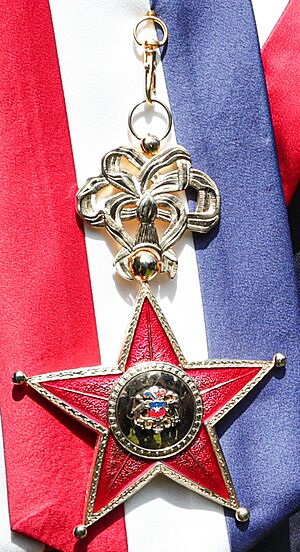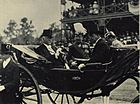President of Chile facts for kids
Quick facts for kids President of the Republic of Chile |
|
|---|---|

|
|
| Executive branch of the government of Chile | |
| Style | His Excellency |
| Residence | Palace of Cerro Castillo |
| Seat | La Moneda Palace |
| Appointer | Popular vote |
| Term length | Four years,
renewable non-consecutively
|
| Constituting instrument | Constitution of Chile (1980) |
| Inaugural holder | Manuel Blanco Encalada |
| Formation | June 9, 1826 |
| Succession | Line of succession |
| Deputy | Ministry of the Interior (as ex officio "Vice-President") |
| Salary | 155,199,315 Chilean pesos/US$190,466 annually |
The President of Chile (in Spanish, Presidente de Chile) is a very important leader in the country. This person is both the head of state and the head of government for the Republic of Chile. The President is in charge of running the government and managing the country. This role has always been one of the most important political jobs in Chile. It helps keep the country stable.
Under Chile's current Constitution, the President serves for four years. They cannot be re-elected right away for a second term. The President's main office is at the beautiful La Moneda Palace in Santiago, the capital city.
Michelle Bachelet made history as the first female President of Chile. She served two terms, first from 2006 to 2010, and again from 2014 to 2018. Currently, Gabriel Boric is the President. He won the 2021 Chilean general election and started his term on March 11, 2022. José Antonio Kast won the 2025 Chilean general election and will take office on March 11, 2026.
Chile's Presidential History
Chile's journey as a nation began in 1541. At that time, it was known as the Kingdom of Chile. The King of Spain was the head of state, but he had a special representative in Chile called the Royal Governor. This governor managed the area for the King. Over time, Chile gained its independence and created the office of President to lead the country.
What it Takes to Be President
Requirements to Serve
The Constitution of 1980, updated in 2005, explains who can become President. To be eligible, a person must be a Chilean citizen from birth. This also includes people born outside Chile if their parents or grandparents were Chilean citizens.
Candidates must be at least 35 years old. They also need to meet all the requirements to become a Senator. This means they must be at least 18 years old and have the right to vote as a full Chilean citizen.
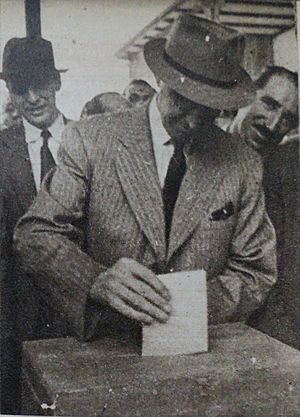
How the President is Elected
The President of Chile is chosen by a direct vote from the people. To win, a candidate needs to get more than half of all the valid votes. If no candidate gets more than 50% of the votes in the first round, there is a second election. This second election, called a "balloting," happens a few weeks later. Only the two candidates who received the most votes in the first round can participate. The person who gets the most votes in this second round becomes President.
Presidential elections are held on the third Sunday of November. This happens in the year right before the current President's term ends.
How Long a President Serves
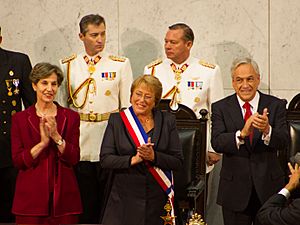
The rules for how long a President serves have changed over the years. Currently, under the 2005 constitutional reform, the President serves for four years. They cannot be re-elected immediately for the next term.
However, a former President can run for office again after someone else has served a term. This means they can serve non-consecutive terms. There is no limit to how many times a person can run for President if they have not served before.
The current President finishes their term on March 11 of the year after the election. The new President, known as the President-elect, takes office on the same day.
Who Takes Over if the President Can't Serve?
If the President cannot do their job, their powers are temporarily given to the Minister of the Interior. This minister then acts as "Vice President." This is not a permanent job, but a temporary role. The minister only performs the President's duties until the President can return or a new President is chosen.
If both the President and the Minister of the Interior are unavailable, another minister from the government takes on the role. The Senate must agree for this temporary Vice President to exercise the President's duties.
Order of Presidential Succession
In 2011, a change to the Constitution set the order of who would become President if needed. Here is the order of succession, with the people currently holding these positions:
- President of the Republic: Gabriel Boric
- Minister of the Interior and Public Security: Carolina Tohá
- Minister of Foreign Affairs: Alberto van Klaveren
- Minister of National Defense: Maya Fernández
- Minister of Finance: Mario Marcel
- Minister Secretary-General of the Presidency: Álvaro Elizalde
- Minister General Secretariat of Government: Camila Vallejo
- Minister of Economy: Nicolás Grau
- Minister of Social Development: Javiera Toro
- Minister of Education: Marco Antonio Ávila
- Minister of Justice: Luis Cordero Vega
- Minister of Labor and Social Provision: Jeannette Jara
- Minister of Housing & Urbanism: Carlos Montes Cisternas
- President of the Senate: José García Ruminot
- President of the Chamber of Deputies: Karol Cariola
Presidential Symbols
The Presidential Sash
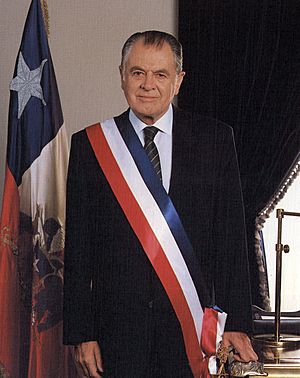
The presidential sash is a special symbol of the President's authority. It was first used by Bernardo O'Higgins. It became an official symbol when President José Joaquín Prieto took office in 1831. The sash has three stripes with the colors of the Chilean flag. It is sewn by hand and is about 75 centimeters (30 inches) long and 13 centimeters (5 inches) wide.
For a long time, there was only one sash passed from President to President. But in 1915, a new sash had to be made because the outgoing President, Ramón Barros Luco, and the new President, Juan Luis Sanfuentes, were very different in height. Since then, each President has their own sash, which they wear only for important official events.
The O'Higgins Pioche
The O'Higgins Pioche is another important symbol of presidential power. It is a five-pointed star, about 7 centimeters (3 inches) wide, and is enameled in red. It is worn at the bottom of the presidential sash. This pioche dates back to the medals of the Legion of Merit. The original pioche was lost in 1973 during a difficult period for the country at the La Moneda palace. During the time of Augusto Pinochet's military government, a new pioche was made to look exactly like the original, using old photographs. It is only worn with the presidential sash.
The Ford Galaxie 500
For many years, the President of Chile used an elegant horse-drawn carriage from France for special events. This carriage was brought to Chile by President José Manuel Balmaceda. However, President Salvador Allende decided to use a black 1966 Ford Galaxie XL convertible as his official car instead. He wanted to show a more modern image, not one of royalty. This car was originally bought in 1968 for Queen Elizabeth II's visit to Chile.
Today, both the historic carriage and the Ford Galaxie are kept by the state. They are used only for very special official ceremonies. These include state visits, national holidays on May 21 and September 19, and presidential inaugurations on March 11 every four years.
See also
 In Spanish: Presidente de Chile para niños
In Spanish: Presidente de Chile para niños
- Vice President of Chile
- Presidents of Chile timeline
- 2021 Chilean presidential election



